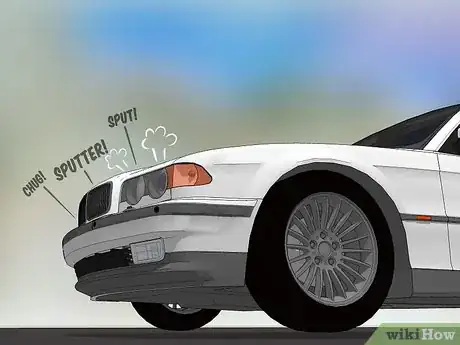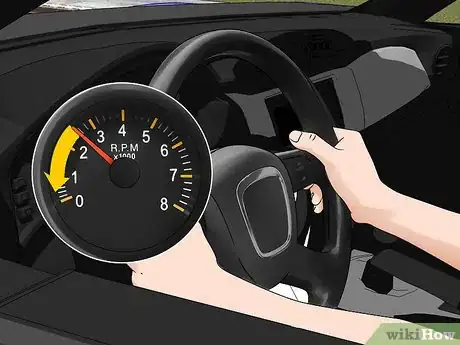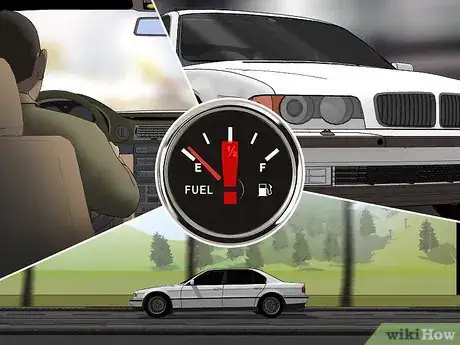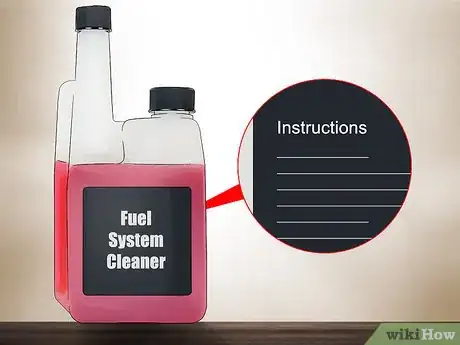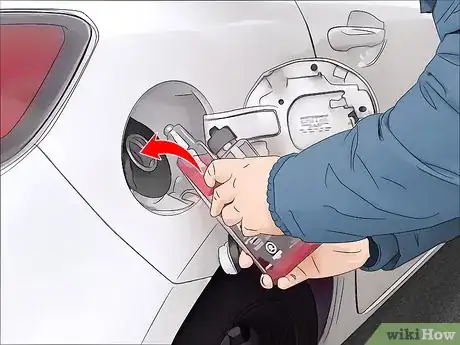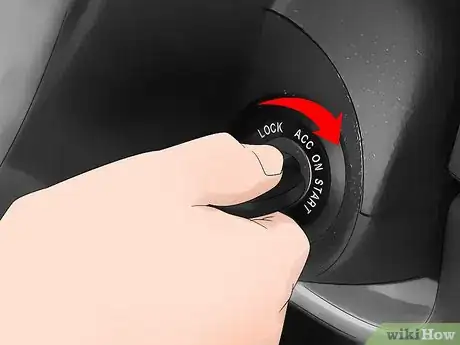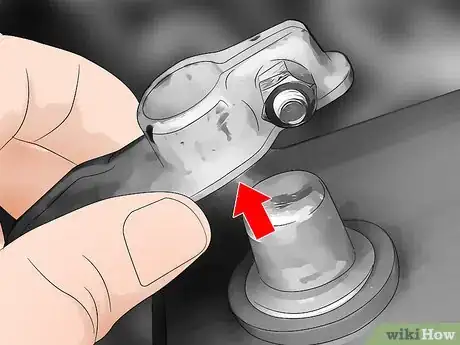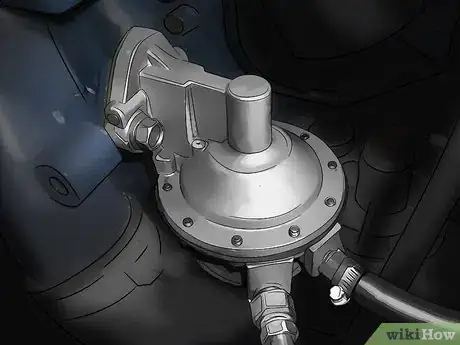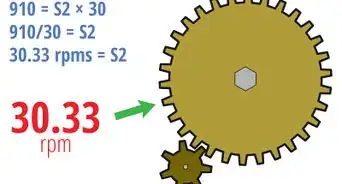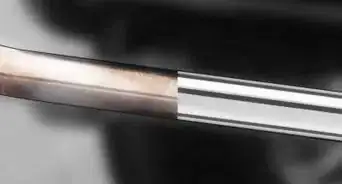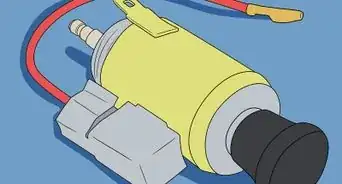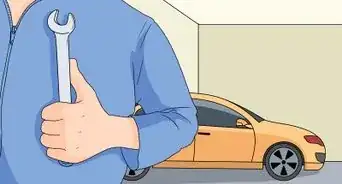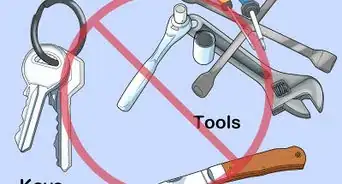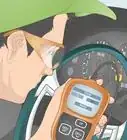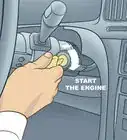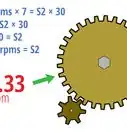This article was co-authored by Ed Beery. Ed Beery is an Automotive Specialist and the Owner of InTechgrity Automotive Excellence based in Denver, Colorado. With more than eight years of experience, he specializes in providing maintenance and repair services for both individuals and companies. Ed and the InTechgrity Automotive Excellence Team are approved by the American Automobile Association (AAA) for repairs and are Automotive Service Excellence (ASE) certified.
There are 9 references cited in this article, which can be found at the bottom of the page.
This article has been viewed 113,871 times.
Most modern vehicles use sealed, filter-less pumps with screens at the pickup and a filter along the fuel line. These pumps are designed not to need maintenance and will need to be replaced if they fail. If your vehicle has an electric fuel pump, you can use a fuel system cleaner to clear any sediment buildup or blockage. If you have a manual one (usually found in older model vehicles), you can actually open the pump to clear debris out of its internal filter, though that isn’t an option in most modern vehicles.
Steps
Spotting the Signs of a Clogged Fuel Pump
-
1Watch out for engine “sputtering” or stalling. The most common symptom of a clogged fuel pump is an intermittent power loss caused by the pump failing to push enough fuel to the injectors to keep the engine running properly. If your engine sputters or even stalls when you take your foot off of the gas, there may be an issue with your fuel pump or filter.[1]
- If the engine stalls, but then will run again after a few minutes, it’s likely because of sediment building up in the fuel filter or pump. As the sediment settles, the blockage clears and that fuel will begin to flow until it builds up again.
- You should also consider replacing your fuel filter.
-
2Listen for a clicking or whining from the pump when the car idles. A clog in the fuel pump will force it to work harder to push the fuel, which can make it burn out. If you hear a clicking or whining noise from the area around the gas tank (rear of the car), chances are it’s the electric motor in the fuel pump beginning to fail.[2]
- Cleaning the pump and replacing the filter may solve this problem if you catch it early, but if you allow it to continue for too long, it will burn out the fuel pump and it will stop functioning.
- It’s not uncommon for the pump to click once when you turn the key, but it should not keep clicking after that.
Advertisement -
3Look for a drop in RPMs as you drive. If you’re traveling down the road at a consistent speed and the vehicle abruptly slows down or the RPMs drop significantly on your tachometer (when equipped), it may be a sign that the fuel pump is struggling to deliver enough fuel to the engine. RPMs are the number of revolutions your engine makes per minute, so a drop in RPMs represents a drop in how quickly your engine is spinning and the power it can produce.[3]
- Look for warning lights on your dashboard that may indicate other potential issues to explain the power loss. A battery light, for instance, might suggest an electrical issue, or a flashing check engine light indicates that the engine is misfiring.
- In the absence of those indicators, sudden (temporary) power loss is a good sign that there’s a problem with your fuel pump.
-
4Consider if you often run the vehicle with low fuel. Gasoline tends to be awfully dirty and that sediment collects in your fuel tank. With a full tank of gas, the dirt in your tank is dispersed through a greater volume of fluid, but when there isn’t much fuel in the tank, the sediment makes up a larger portion of the fuel. Imagine a fish tank: when full, the gravel at the bottom is just a small part of what’s inside, but when the tank is almost empty, the gravel and little water that’s left occupy the same space.[4]
- If you regularly drive with low fuel, there’s a higher likelihood that your fuel pump and filters are getting clogged.
- Use this determination along with the other symptoms listed above to determine if there’s an issue with your fuel pump.
- If you use fuel of poor quality, it will cause the tank clog faster.
Using a Fuel System Cleaner
-
1Read the instructions on the bottle. While most fuel system cleaners work in roughly the same ways, there are differences from brand to brand. Read the instructions on the fuel system cleaner you purchase thoroughly to ensure you follow the right steps.
- You can purchase fuel system cleaner at many large retail stores as well as all auto parts stores.
- Purchase fuel system cleaner, not injector cleaner. These products are similar but serve different purposes.
-
2Run the engine until you’re nearly out of fuel. Most fuel system cleaners are meant to be poured into an empty fuel tank so it can mix with the fuel you add to it after. Run your engine until the fuel gauge reads as empty or “E.”
- The tank doesn’t need to be completely empty and free of fuel. It just needs to be as low as possible.
-
3Pour the contents of the fuel system cleaner into your gas tank. Open the bottle and puncture the plastic seal beneath the lid. Then insert the spout of the fuel system cleaner into the gas filler neck of your vehicle just like you normally would with a gas pump.[5]
- Most fuel system cleaners come with enough for one treatment. If yours comes with more than that, read the instructions to determine how much of the bottle to add to your tank. In some cases, a couple of rounds of fuel additive may be needed.
- Gloves aren’t necessary for this task, but you may want to wear them to keep any fuel system cleaner from getting on your hands.
- If you get any of the fuel system cleaner on your hands, wash them with soap and water.
-
4Fill your tank with pump gas. The new gas you pump into the fuel tank will mix with the fuel cleaner already present. This will ensure the cleaner is properly dispersed throughout the fuel and will also help the pump to begin picking up fuel with the cleaner in it right away.[6]
- Fill the tank all the way with new gas.
- Use the same octane fuel you always use.
-
5Start the engine and let it idle for a few minutes. The fuel system cleaner will flow through the fuel pump and filter on its way to the engine where it will burn along with the gas. As it passes through, it will begin to break down deposits of sediment in your fuel pump and throughout the rest of the system.
- Many fuel cleaners recommend letting the engine idle for ten or fifteen minutes to start letting the fuel and cleaner flow through the system before you start driving the car again.
- After that initial stage, you can drive the vehicle like normal as it cleans your fuel system.
Cleaning Mechanical Fuel Pump Filters
-
1Disconnect the negative terminal on the battery. Locate the battery in the vehicle’s engine bay or trunk. It will look like a black box with two posts sticking out of it. Locate the positive (+) and negative (-) terminal posts and use the correct sized wrench to loosen the nut holding the cable to the negative post. Then slide the cable off.[7]
- The terminals will be labeled with positive (+) and a negative (-) symbols.
- Disconnecting the battery is especially important when working with fuel to ensure nothing within the vehicle can produce a spark.
- Tuck the negative cable to the side of the battery to ensure it doesn’t come into contact with the terminal by accident.
-
2Locate the fuel pump. Mechanical fuel pumps are usually found on the engine, rather than in the fuel tank, because they rely on the crankshaft to power them. Refer to an application specific repair or service manual to help you identify and locate the mechanical fuel pump in your particular vehicle, as they can vary widely in appearance and location.[8]
- Most mechanical fuel pumps will have a portion that looks like a metal circle with a nozzle coming out of the top or bottom.
- Mechanical fuel pumps are usually only found in older vehicles.
-
3Place a container beneath the vehicle to catch any leaking fuel. Depending on how the fuel pump is mounted, there’s a high likelihood that you’ll spill at least some fuel in this process. Slide a container beneath the vehicle directly under the fuel pump you’ll be working on to catch any fuel spillages as you work.[9]
- Make sure the container you use is rated for fuel. Gasoline can melt through some types of plastic.
- Containers rated to hold gasoline will be labeled as such. If your container is not labeled, do not assume it can hold gasoline.
-
4Remove any fuel lines only if they’re in the way. There will be two fuel lines on the pump (an in and an out). If possible, leave them in place as you open the fuel pump, but if you have to remove one or both to access the internal filter on your specific vehicle, do so by either unscrewing the lines or by loosening the hose clamps that are holding them securely on their nozzles. Once the clamps are loose, just pull the line backward off of the nozzle.[10]
- Make sure any fuel draining from the line falls into the container you slid beneath the car.
- If you have zip ties, you can zip tie the lines with the opening facing up to prevent any more fuel from pouring out. You’ll need to break or cut the zip ties when reconnecting the lines.
-
5Remove the central screw or nut from the top of the fuel pump housing. There will be a nut or a bolt sticking out of the top of the mechanical fuel pump that holds the cover over the fuel filter. Find it and then use the correct sized wrench to remove it so you can access the filter inside.[11]
- In some pumps, there may be a cylindrical filter housing on the top that you can unscrew by hand, instead of a bolt or nut.
- Others may use pipe clips to hold the cover in place. Loosen the screws securing them or pull them off with pliers, depending on the type of clip.
-
6Clean the filter with a brush without removing it. Look into the fuel pump to see the filter, which will look like a screen. Don’t try to remove the filter, but instead use a clean paint brush to sweep away any debris blocking the filter. You can dip the paint brush in new gasoline to make it easier for the debris to stick to the bristles of the brush.[12]
- Use a medium sized paint brush to remove large and small bits of debris. The brush should be no wider than the body of the fuel pump.
- Many internal fuel filters for these pumps cannot be removed.
- In some vehicles, however, you can remove the filter and replace it if need be. Refer to a vehicle specific repair manual to help you determine if that’s the case for your car or truck.
-
7Reassemble the fuel pump. Put the cover back on the fuel pump and then secure it in place using the bolt or nut you removed before. Reconnect any fuel lines that you disconnected and use hose clamps to make sure they’re tight.[13]
- You can purchase replacement hose clamps at your local auto parts store if you need them.
- Most hose clamps can be tightened with either a Phillips head screwdriver or a small wrench.
Community Q&A
Did you know you can get answers researched by wikiHow Staff?
Unlock staff-researched answers by supporting wikiHow
-
QuestionHow do you free up a stuck fuel pump?
 wikiHow Staff EditorThis answer was written by one of our trained team of researchers who validated it for accuracy and comprehensiveness.
wikiHow Staff EditorThis answer was written by one of our trained team of researchers who validated it for accuracy and comprehensiveness.
Staff Answer wikiHow Staff EditorStaff Answer
wikiHow Staff EditorStaff Answer -
QuestionWhat kills a fuel pump?
 wikiHow Staff EditorThis answer was written by one of our trained team of researchers who validated it for accuracy and comprehensiveness.
wikiHow Staff EditorThis answer was written by one of our trained team of researchers who validated it for accuracy and comprehensiveness.
Staff Answer wikiHow Staff EditorStaff Answer
wikiHow Staff EditorStaff Answer -
QuestionHow much does it cost to clean a fuel pump?
 wikiHow Staff EditorThis answer was written by one of our trained team of researchers who validated it for accuracy and comprehensiveness.
wikiHow Staff EditorThis answer was written by one of our trained team of researchers who validated it for accuracy and comprehensiveness.
Staff Answer wikiHow Staff EditorStaff Answer
wikiHow Staff EditorStaff Answer
Things You'll Need
- Fuel system cleaner
- Open ended or Socket Wrenches
- Container to catch fuel
Warnings
- Working with fuel can be extremely dangerous. Keep sparks and open flames away from your work area until all fuel has been cleaned up.⧼thumbs_response⧽
- Only use containers that are rated to hold fuel and make sure to label them appropriately.⧼thumbs_response⧽
- Wear eye protection and gloves whenever coming into contact with fuel.⧼thumbs_response⧽
References
- ↑ https://www.autoserviceprofessional.com/article/100318/fuel-pump-101-the-basics-of-fuel-pump-diagnosis-and-repair
- ↑ https://www.micksgarage.com/blog/common-fuel-systemfuel-related-problems-fix
- ↑ https://www.micksgarage.com/blog/common-fuel-systemfuel-related-problems-fix
- ↑ https://jalopnik.com/why-you-shouldnt-run-your-car-low-on-gas-1796273605
- ↑ https://youtu.be/wMMUHbNbWJ8?t=44s
- ↑ https://youtu.be/wMMUHbNbWJ8?t=1m16s
- ↑ https://www.popularmechanics.com/cars/how-to/a1454/4213127/
- ↑ https://dannysengineportal.com/mechanical-fuel-pumps/
- ↑ https://www.2carpros.com/articles/how-to-replace-an-electric-fuel-pump
About This Article
If your engine is sputtering, stalling, or making a clicking sound, it might be time to clean its fuel pump. To do this, all you’ll need is a bottle of fuel system cleaner and some gas. You’ll need to run your engine until it’s nearly out of gas before you pour in the fuel system cleaner. Just pour the bottle into your gas tank like you’d fill it with fuel. Then, fill the tank with gas. Let the engine idle for 10 to 15 minutes so the cleaner can work its way through the engine and filters. After that, you can drive your vehicle like normal while the cleaner works its magic. For more tips, including how to clean a mechanical fuel pump filter, read on!
